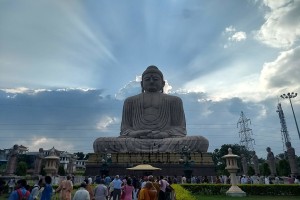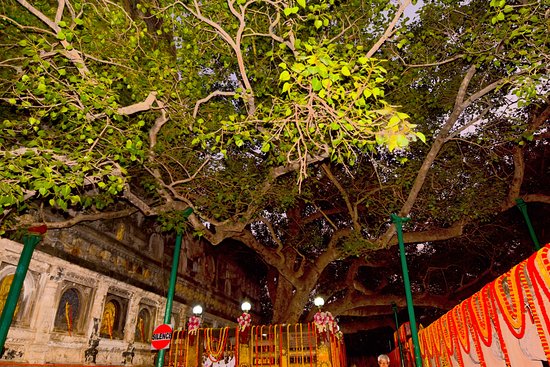
Photo credit: Nirasindhu Desinayak
 By Nandini Bhushan
By Nandini Bhushan
Bihar has derived its name from the word “Vihar”, which means monastery, a place where monks lived together. It was here that Buddhism flourished in its initial day and the region was dotted with some of the important Buddhist monasteries or Vihars.
Such is the essence of its historical importance that Bihar itself represents history. Indian civilisation is believed to be one of the oldest civilisations in the world and Bihar has occupied the central place of activity and the seat of power for a major period of this great civilisation.
Yet, despite its historical importance, Bihar has been quite underrated and not a popular destination among tourists exploring the places witnessing great moments of history, largely because of the ignorance of people, just as most people are about Bihari cuisine. The fact is that Bihar has been an integral part of our glorious Indian history, yet it remains an unexplored historical travel destination, and has therefore been quite underrated among tourists. Blessed with remarkable relics and monuments from ancient dynasties and deeply linked with Indian history as a spiritual and learning center, it definitely deserves better treatment.
In this blog, I bring to you the historical sites of Bihar and its glorious past. Here is Bihar from the lens of an avid history lover to give you a chance to peep in the rich heritage of this glorious land of Buddha.
Bodh Gaya
The land of Enlightenment and Salvation is one of the most cherished of all the Buddhist sacred sites . Such is its religious significance that this Buddhist holy site is flocked by devotees from all across the world to explore its culture and rich heritage. Bodh Gaya is one of the four important Buddhist sites that includes Kushinagar, Lumbini and Sarnath.
Also read: Tourist places of Bihar: A glimpse into ancient Magadh -Part 5
Bodh Gaya lies about 115 Km from the state capital Patna and is a sanctorum where the religion Buddhism was conceived and created. The glorious history of the town traces back to 500 BC where historians mentioned it as Bodhimanda and the main monastery as the Bodhimanda Vihara. Until the eighteenth century CE it was known as Sambodini Vajrasana where as it was such an important pilgrimage centre that famous travellers like Xuanzang and Fa Hien visited this place between 5th and 7th century.

Born as Prince Siddhartha into a royal family, the young prince left behind his family and royal responsibilities in search for peace and it was eventually in Bodh Gaya that the wandering prince sat under a peepal tree to meditate. The first three days of his meditation and the following seven weeks of enlightenment is closely associated with various places Bodh Gaya. While wandering near the Falgu river bank seeking answer, the lord finally sat under the peepal tree meditating for three days and night and finally attained enlightenment and came to be known as “Buddha” or the enlightened one.
The Bodhi or the Bo tree, an ancient and sacred fig tree located in Bodh Gaya holds a great significance in the history of Buddhism. A simple shrine was built by Emperor Ashoka in the third century BCE to mark the significant site of enlightenment and was later enclosed by a railing made of stone. However during the Kushar period in the 2nd century BCE, the shrine was replaced by Mahabodhi temple that is one of the oldest and most remarkable brick temples of India and is an architectural amalgamation of many centuries, culture and heritage. This UNESCO World Heritage site was further restored by a British archeologist in the second half of the nineteenth century.

The Bodhi tree stands adjacent to the temple although the present tree is considered to be the direct descendant of the original tree The complex is spread over an area of 11.9 acres that hosts ancient shrines as well as modern structure built by the Buddhist devotees. The Vajrasana or the diamond throne is placed to mark the exact position where the Buddha sat. The sacred bodhi tree, the shikhara tower and six other important and sacred sites of Buddha’s enlightenment is also a major tourist attraction .Besides the lotus path of Lord Buddha is believed to be a path where Buddha walked a day after his enlightenment, although located outside the complex , is visited by the devotees too in a large number. Apart from this there is ancient Dungeshwari cave temples or Mahakala caves at about 12 kms away from the city features Buddhist shrines and is believed that Lord Buddha meditated at this place for almost six years before he went to Bodh Gaya and achieved enlightenment. Most of the oldest sculptural elements have been moved to a museum built beside the temple. The Buddhist temple of China, Tibet, Japan, Thailand and Bhutan is also a major tourist attraction in the modern times. Bodh Gaya prospered and developed for many centuries but was eventually attacked and finally conquered by the Turks in the 13 th century.
The intense devotion, the chanting and prayers, the tranquility , the positive vibes across the premises makes Bodh Gaya one of the most pious and spiritual global destinations for spiritual enlightenment.







Well articulated and good information
👌👌